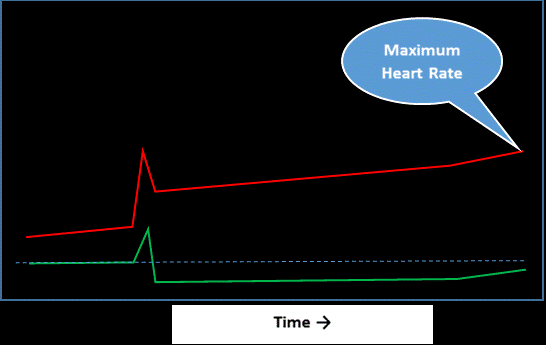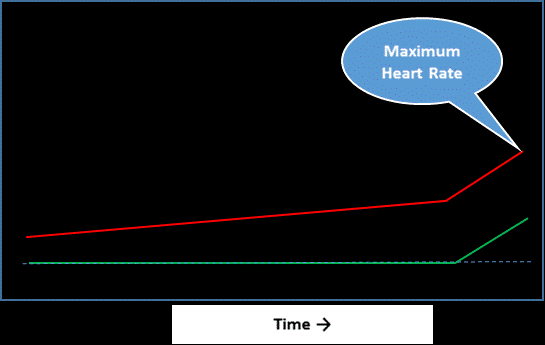 |
 |
 |
 |

 |
Heart Rate Training |  |
|---|
See the Index for more topics, information, hints and tips.
Check with your doctor first before beginning any intense training.
It turns out that your heart rate is a pretty good indicator of effort. Managing your heart rate should be a priority for you throughout a run/race.
Heart rate is usually expressed as a percentage of your maximum heart rate. This just makes the numbers easier and since your maximum heart rate declines with age, dealing with percentages normalizes it so you can easily talk with others.
There are a number of equations for calculating your maximum heart rate that various people have come up with over the years. The simplest is:
Max heart rate = 220 Ė age
But this seems to be low for athletes especially people who have been runners for many years. This formula may be better for runners:
Max heart rate = 207 Ė 0.7 * age
Factors that influence your heart rate include: heat, humidity, stress, sleep, and caffeine.
Your resting heart rate or minimum heart rate is a gauge of how physically or aerobically fit you are. Some elite long distance runners have resting heart rates in the 30ís. To measure your resting heart rate you need to be totally relaxed and laying down on your back. Taking your pulse first thing in the morning is a good way of doing this. You need to simply count the number of times your heart beats in a minute. Another way of doing it is to wear your heart rate monitor to bed and note what it reports in the morning when you first wake up.
Heart rate monitors are most helpful in keeping you in the correct training zone. This is especially helpful on your easy runs when you are more apt to cheat and monitoring your effort in long runs or races.
Iíve used a heart rate monitor for years. It usually is a pretty good indication to me as to how hard Iím pressing. I know that early in a hard run or race my heart rate will be about 80% of max. But towards the end it will get upwards of 95%.
If you have a popular route or part of a route that is especially challenging to you or you are working on, you might do it every two or three weeks. Use it as a measuring stick to get a feel of your progress. You can do this strictly by time to complete or time to complete while keeping your heart rate under a specific value or percent. Another variation of this is to see how far you can run in a specific time while keeping your heart under a specific value.
Another useful thing to do is to measure your recovery heart rate. This is a measure of how much your heart rate drops a set amount of time (one or two minutes) after you complete a workout. What you do after your workout (walk, sit, lay down ...) will add some variation to this measurement. You should see a drop of maybe 30 to 40 beats per minute. If it is a very small drop that is an indication that you are overtraining. See Types of Running Workouts and be sure not to do two hard workouts in a row.
Beginning runners tend to spend most of their time training in the 65% to 85% range. Most elite runners spend their time outside that range. They take it easier on easy days and press harder on hard days.
A spike in your heart rate early in a race because of a tough climb or to jockey for position can be costly.† It may save you a minute at the time, but cost you a minute per mile for the rest of the race.† Thatís why it is so important to go out slow.
Learn through your long run and races what heart rate you can sustain for periods of time/distances.† You will find that you can put out a greater effort (higher heart rate) for a 5K than you can a longer race.† You wonít be able to maintain that heart rate for a longer race.†
During your training keep track of your heart rate while you run. See what range of heart rates you feel good in and when you are starting to suffer. Then when you are developing your race day strategy add heart rate goals like keeping your heart rate below 75% the first few miles and 85% for the first half. Your experience will help you set these goals.
Other conditions will influence your heart rate like heat, humidity, stresses in your life, sleep, and how hard you have trained in the prior week or two.
Your heart rate will start out low at the start of a race and slowly climb through the race.†
Eventually you will get a good feeling for what heart rate you can sustain for various distances.
I HIGHLY recommend using percentage of your max heart rate instead of actual beats per minute. Using percentage of your max heart rate is a great way of normalizing your heart rate so that you can compare it to other people or to yourself over time.† If you tell someone your heart rate is 140 bpm that means very little to them Ė depending on age and fitness level that could be near their maximum or a rate they could maintain for 24 hours.† Telling them your heart rate is at 75% of maximum lets them know very precisely where you are at, what kind of effort you are putting out.† And for some reason remembering your percent rate of max which will probably be a number between 70 and 100 is a lot easier to remember than a heart rate between 100 and 180. Since your heart rate max decreases by about 1 beat per year, you will notice the difference in just five years.
If your heart rate is low but you just can't run as fast as you think you should then that could be an indication that you are low on fuel. Take some fast acting simple carbohydrates like honey or agave nectar to help you recover.
If you get your heart rate up high early in a race or run say by aggressively climbing a tough hill near the start, you may never be able to recover and may suffer for the remainder of the activity. Even if you walk and get your heart rate back down, as soon as you start running it will go back to a higher level than what you want. Iíve tried to illustrate that in the graphs. The right one shows an ideal steady effort throughout with a kick towards the end of the race. The left one shows how you are not able to recover your prior lower heart rate after a surge and your speed suffers for the remainder of the activity.
 |
 |
|---|
